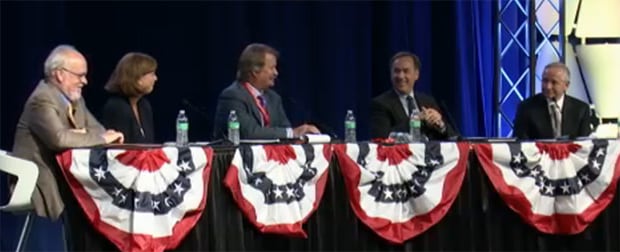Western Region Power Grid: Coming Soon?
Panelists debating the pros and cons of a regionalized western power grid seemed to agree that the development of such a system is inevitable, but they disagreed on how fast the evolution should occur.
The panel discussion took place during the California Independent System Operator (ISO) Stakeholder Symposium held on September 7 in Sacramento. At one point, the moderator of the session, John Danner, senior fellow at the University of California, Berkley, Hass School of Business, suggested that the dialogue had progressed beyond the question of whether or why a regional approach might be beneficial, to a debate about how and when it should be implemented (Figure 1).
“It’s certainly true that the physics suggest operating a bigger grid is better,” said Marc Joseph, attorney with Adams, Broadwell, Joseph, and Cardozo, “but . . . the politics—the policy—is still up in the air.”
Strange Bedfellows
Joseph said it’s not really clear if there is any intersection between the policies of California and those of the Mountain states. He suggested that while states like Utah, Idaho, and Wyoming talk about clean living, they don’t do it with clean generation.
“This would be a marriage of two regions of the country with vastly different policies. In fact, completely—180-degrees—opposite of each other, so I don’t think it’s a given that what’s currently proposed is the optimum path,” Joseph said.
But Jan Smutny-Jones, CEO of the Independent Energy Producers Association, said that although there are areas of friction that would need to be addressed, he didn’t see any challenges that are insurmountable. Smutny-Jones, who represents California’s wholesale electric generation industry, suggested the effort should move “full-speed ahead.”
Rob Lapsley, president of the California Business Roundtable—a nonpartisan organization formed to identify issues important to a healthy business climate—suggested that time should be taken to fit all the pieces together appropriately. Lapsley admitted that a regional approach is ultimately needed, but he suggested that in order to grow jobs in California, cost, reliability, and transparency would be crucial to a successful changeover.
“Our caution on this is: you can’t rush. It’s got to be done in a careful way,” Lapsley said.
Win-Win Opportunity?
Smutny-Jones acknowledged that there are challenges. Two that he specifically pointed to were that the natural gas–fired fleet would need to operate differently than it has in the past and that the renewables portfolio would need to be expanded by developing additional geothermal energy and utilizing more biomass.
“The fact of the matter is that at certain times of the year, we have excess renewables that we need to do something about, and my job is to try to expand that market,” Smutny-Jones said. “Where can we expand that? We can expand it throughout the rest of the west.”
If a western grid were developed, it would hardly be the first regional system in the U.S. Anne George, vice president of external affairs and corporate communications for ISO-New England (ISO-NE), offered perspective from one such regional operator. She said that when ISO-NE formed in 1997, the states involved raised a lot of the same concerns she was hearing today in the west. They were worried that they would lose control, absorb greater costs, and be unable to control their own destinies, but now she believes that all of the New England states see a lot of value in being part of a regional grid and wholesale market.
Getting on the Same Page
However, Joseph argued that California has a history of adopting self-serving policies. He said when the renewable portfolio standards were first passed in the state about 15 years ago, there were three reasons offered for the action. They were to improve California’s air quality, to give Californians rate insurance, and to grow California jobs.
“The lesson from this is not at all surprising, California adopts policies to help California,” Joseph said. “There’s no reason to think the legislature would authorize regionalization without protecting California jobs.”
Yet, Joseph said that he is “cautiously optimistic” that both job preservation and regionalization can be accomplished.
So, how do you move from point A to point B? George advocated for getting the broader region involved in the discussions.
“We’ve seen in New England, when the New England governors get together and they agree on a certain path, that is a pretty strong message,” she said. “Whether this is at the governor’s level, whether it’s at the legislative level, or the market participant level, you need to have some of those conversations.”
—Aaron Larson, associate editor (@AaronL_Power, @POWERmagazine)
